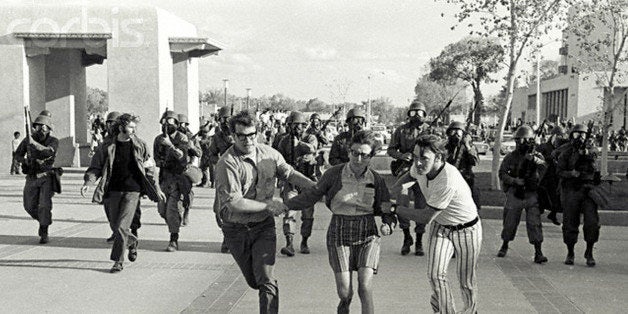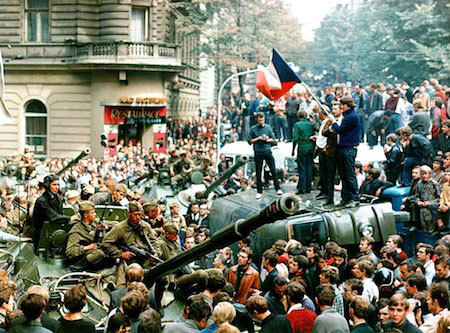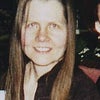
It was May 4, 1970. We were high school seniors in Greater Cleveland, when Kent State exploded on a Monday, a mere 45 miles away, 45 years ago. Four students killed, nine wounded by National Guard gunfire. It's as if it were yesterday.
"How could this happen in America?," I thought at the time, harkening back two years earlier to my summer of 1968 in France, when Czech students took to the streets as Soviet tanks rolled through, crushing Czechs' reforms. I was studying the French language and culture under the auspices of the Utah-based Foreign Study League. My parents had scrimped and saved to give me this opportunity. But at age 15, in Evian, France, we foreign students, were a little too close for comfort to Soviet-overrun Czechoslovakia for our families back home.

Photo Credit: US State Department's website. Czech youths holding Czechoslovakian flags stand atop of an overturned truck as other Prague residents surround Soviet tanks in downtown Prague on Aug. 21, 1968. (AP Photo/Libor Hajsky/CTK)
I could see the apprehension give way to relief in my Bohemian grandmother Laura's eyes as I came down the plane's stairs safe and sound, returning home to Cleveland that August, escaping the tumult taking place in her mother's (my great-grandmother's) homeland. No doubt remembering, too, when her son (my father), returned home to Cleveland the summer of 1945, having survived the fighting in Europe during WWII. I was wearing a floral blazer with a white lacy shell underneath and a matching periwinkle blue pencil skirt with nylons and polished penny loafers. In those days, people wore their Sunday best when flying. As we hugged, I saw the tears in grandma's eyes with my parents standing nearby.
Now I have a nephew, a freshman, attending Kent State with campus commemorations open to the public, taking us back in time to those fateful noontime shootings. For the first time in 2015, a Kent State president, newcomer Dr. Beverly Warren, addressed the crowd on this anniversary date.
Tonight, I will phone a high school friend who started her freshman year at Kent State, a few short months, following the shootings. At our high school prom with our dates and nosegays, the preferred floral arrangement then, she wondered if she had made the right decision to attend Kent State, a decision she reached mainly because of the scholarship assistance which she would forfeit if she didn't go. She wasn't the only one sitting around a prom dinner table that night on their way to Kent State in September, second-guessing themselves.
Five years later in 1975, I found myself doing news reports from Cleveland for Westinghouse Broadcasting, also known as Group W, on the Kent State federal civil trial, where the parents of those killed along with the students wounded by National Guard gunfire were seeking money damages.
A high school friend sitting on a beach with her transistor radio propped up to her ear, dropped me a note, saying she had heard my Kent State trial reports on WINS-AM, an all-news New York City radio station. For a cub reporter, that was quite a thrill, yet bittersweet. When Kristin heard me on-air for the first time, I was reporting such a sad saga stretching back to our high school days together, a time when we dreamed of going to Seven Sister colleges far away from Cleveland, called "the mistake on the lake" in those days, and then we did.
A radio announcer from rival station, WERE-AM Radio in Cleveland, shouted into the microphone, "Not a penny," in relaying the news that a Cleveland jury had found in favor of the guardsmen and the governor. Years of appeals ensued going all the way to the U.S. Supreme Court with many twists and turns along the way.
But what hurt most that day to my 20-something ears, was what I overheard the middle-aged anchormen saying to each other off the air in WJW-AM Radio's newsroom, the birthplace of rock 'n' roll, and where I anchored the afternoon news, the first woman to anchor and report news in that station's 50-year-history. Most were my father's age, some even my grandfather's age. They were delighted the parents of the students killed and the wounded students didn't get a penny and weren't shy about saying so aloud. So much for being objective journalists.
In 1980, around the tenth anniversary of the shootings, I interviewed wounded student Alan Canfora for Group W's WIND-AM Radio in Chicago. Canfora had been saved from death by an oak tree that took the bullets for him when the National Guard opened fire. I had also interviewed Canfora for an Akron, Ohio station, country music station, WSLR-AM "Whistler" Radio in 1978, just months before an out-of-court financial settlement was finally reached. The parents of the dead students reportedly ended up getting $15,000 each, the student paralyzed for life from bullets shot at him $350,000, the other three wounded students got amounts ranging from $15,000 to $42,000. Lawyers fees and court costs totaled $75,000.
Living in Canton, Ohio not far from Kent State, my uncle's dying wish was to live to celebrate his 90th birthday on Friday, May 1st, 2015 with his family all around. He did. A few days later, he breathed his last breath at 4 AM on May 4th, the anniversary of Kent State. Makes you think. A lot.
A woman from my college alma mater, Sherrilyn Ifill, Vassar '84, a cousin of PBS' Gwen Ifill, heads the NAACP Legal Defense Fund. She talked about possible solutions to the unrest and violence in the streets of Baltimore on CBS' Face the Nation , Sunday, May 3, 2015.
Wonder how my uncle who died after a lengthy illness on May 4, 2015, a psychiatrist by profession, would have commented on Baltimore. On my blog. Or over the phone. As he often did.
In Baltimore. Not the same National Guard troops as at Kent State. Different bodies in those uniforms. Different buildings destroyed in protest. Different cities. Different issues being protested. Yet in some ways, all the same. Making a difference. Or not.
From long ago, Crosby, Stills, Nash, & Young's protest song, "Ohio", written to tell Kent State's tale.
Lonna Saunders may be reached at lonna2@ msn.com.
